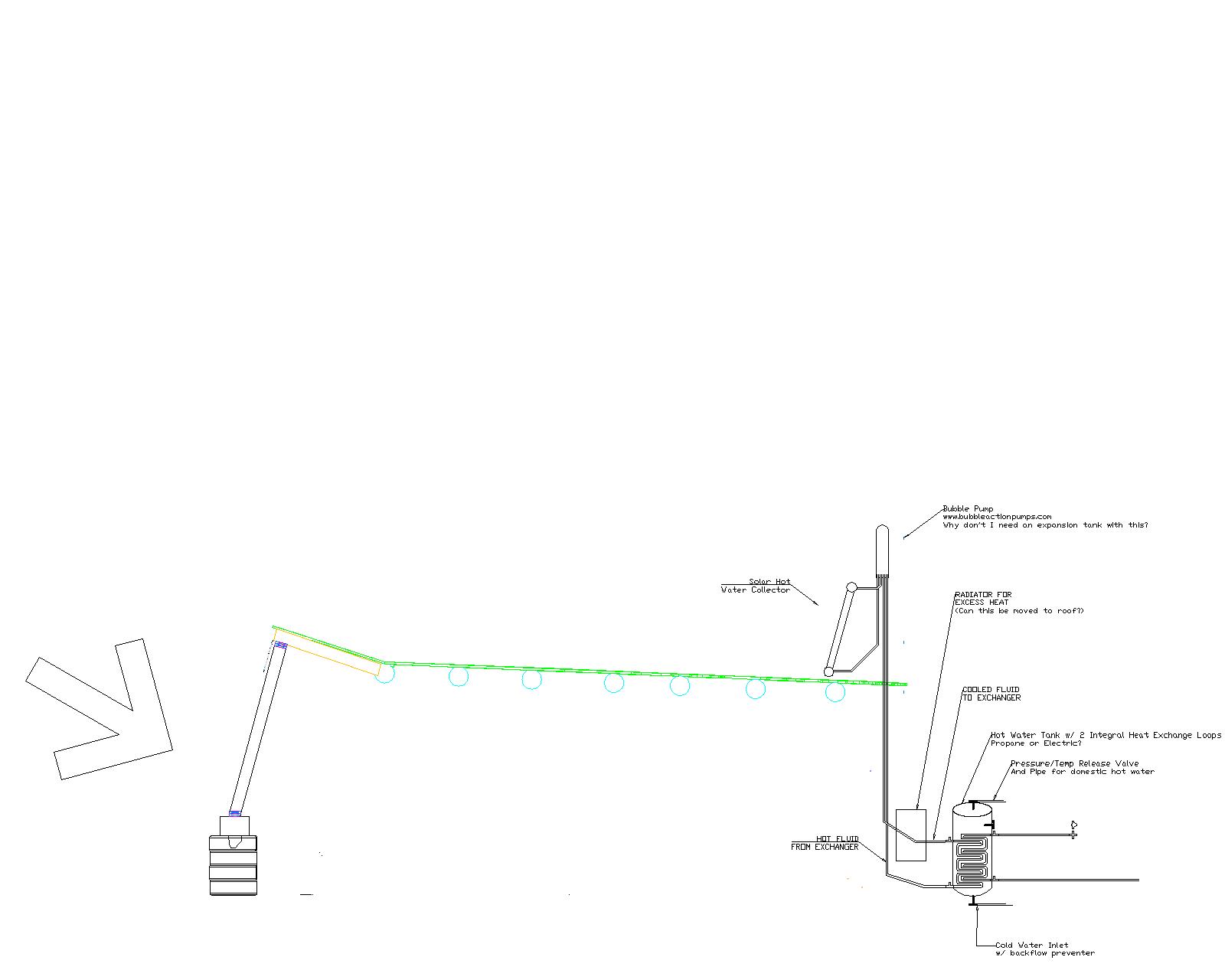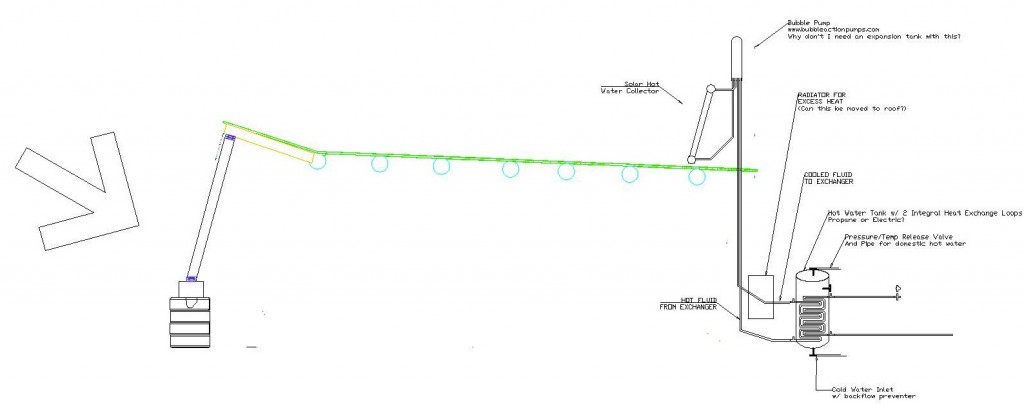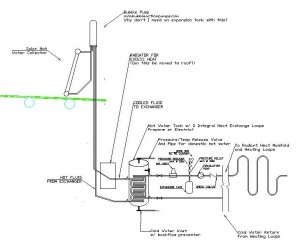
I’ve done a lot of reading lately as I layout the plumbing for our home.
The funniest statement I read became the title of this post … let’s try not to kill ourselves while building our dream home!
Before I dive into the solar heated water I want to back up a bit … what I have been doing over the last few weeks is try to come up with a plumbing plan for this building. This has proved far more complicated than I anticipated; I don’t have extensive experience in plumbing, and many of the systems going into this house are not typical. Regardless, stuff happens and apparently it also flows down hill … how hard can it be?
The plumbing for this project includes:
- Domestic water supply,
- Grey water planters,
- Septic system and associated plumbing,
- Solar hot water heating,
- Radiant floor heat
Domestic water supply
The domestic water supply for our house includes the following fixtures:
- kitchen (sink, dishwasher although we may not install one, we wanted to have the hook-ups)
- main bathroom (tub, sink, washing machine, toilet)
- ensuite bathroom (shower, sink, toilet)
- Hot Water (tank?)
Grey water Planters
Here again not a lot of thought has gone into the final design of the planters.
We have chosen to set the highest point of the planters at the east edge of the building and slope them down to the west edge of the building. This means the flow of grey water is set and we need to get all of the grey water from the plumbing fixtures to the east-most planter. To accommodate this layout our bathrooms will probably be a step-up from the rest of the floor plan … this will (hopefully) give us the height we need to get the grey water to the east edge of the building.
The other choice was to set the lowest planter in the middle of the building and have the grey water run to this point from two directions … this seemed more complicated and frankly we did not plan for this early enough … the benefit of this layout would have been smaller elevation changes due to shorter travel distances (possibly no step-up into the bathrooms).
Septic System and Associated Plumbing
This is actually where I started thinking about the plumbing … unlike everything else in this building a septic system has well defined code requirements and is fairly straight forward to implement.
The waste pipe layout is complicated by the need to separate out the grey water flow from the flow from the black water fixtures and run it to the grey water planters. In our layout the grey water flow will be valved; it will either flow to the grey water planters or out to the septic tank. This means that we are compliant with the building code, and did not have to try and prove that we did not need a code compliant septic system for this building. We had an existing septic tank and field on our site and to get a permit we just had to have a certified septic installer o.k. our system.
Solar Hot Water Heating
There are a lot of options to consider when using solar heat, and everybody seems to be pushing their design as the greatest thing since sliced bread. Added to this, the BC Building code (I believe this is similar across Canada) places restrictions on what you can use … all of this makes specifying a system challenging.
For a good introduction on different solar options this article helped me.
I found the following questions (taken from the website that warns against making a solar bomb) to be helpful …
The Fundamental Questions
- Does the proposed system operate at low temperatures? Solar collectors are not very efficient at temperatures of 180°F.
- Has the need for storage of solar energy been considered?
- How will excess heat be handled?
- How will the need for freeze protection be handled?
- What will happen if the electric power fails in the middle of the day?
- What will happen when the power comes back on after a period of stagnation?
- If something goes wrong, will the system fail to a safe condition
(fail safe)?- How will the occupant know if the system is not working properly?
Keeping these questions in mind the first system that occurred to me was an open-loop system that relied on a thermosiphon to pump the water around. Confused yet? This compares to a closed-loop system with glycol (antifreeze) and an electrical pump. Read on … it gets worse!
We have already identified the need to block at least the lower half of our bathroom windows … its a privacy thing. It occurs to me that this window space could be ideal for solar collectors … I even picked out evacuated tube solar collectors … these babies would obscure the view without completely blocking the sunlight … sort of like frosted glass … only functional!
- Will the lines close to the glass risk freezing at night, or if the building is un-occupied for an extended period of time? Our building interior has not dropped below freezing in the two years it has been standing, but we have seen frost build up on the windows … a pipe close to the windows may risk freezing.
- Will the system generate a lot of undesirable waste heat in the building envelope during the summer months?
I am still tossing this idea around … variations on it are used in warmer climates.
With those considerations in mind the system that is currently winning is shown in the following image.
 The solar panels are on the roof so it is a close-looped system and would use an anti-freeze solution in the heat exchange loop. The necessity for an electric pump is eliminated by using a bubble pump … a solar pump that pumps when the sun is out by establishing a thermosiphon loop. This pump is passive in that it works when the collectors are heated by the sun and shuts down when the sun is gone … which is pretty much when you want to pump … eliminating the need for an electric pump and a controller.
The solar panels are on the roof so it is a close-looped system and would use an anti-freeze solution in the heat exchange loop. The necessity for an electric pump is eliminated by using a bubble pump … a solar pump that pumps when the sun is out by establishing a thermosiphon loop. This pump is passive in that it works when the collectors are heated by the sun and shuts down when the sun is gone … which is pretty much when you want to pump … eliminating the need for an electric pump and a controller.
The hot water tank is used for storing the solar heat. The tank could have an electric backup element or be propane … meaning that you will always have hot water … I still have not figured out which is the better option.
Radiant Floor Heat
We plan to have radiant floor heat in the high-use floor spaces of the earthship. My intention is to use the solar heated water for the heating loops.
I am still trying to work this out but will look something like:
 This means that the hydronic heating loops will not be passive, an electric pump will be used to move the water. I have read about using a thermosiphon loop for this, but they still had a backup pump in case bubbles blocked the thermosiphon … so I do not think making this an active loop is a bad idea. Our intention is to use a wood gasifier to produce electricity … the gasifier will also generate a lot of heat and I see it being primarily responsible for providing heat for the radiant floor system. I have not shown it in this diagram because I am still wrapping my head around how it will be implemented.
This means that the hydronic heating loops will not be passive, an electric pump will be used to move the water. I have read about using a thermosiphon loop for this, but they still had a backup pump in case bubbles blocked the thermosiphon … so I do not think making this an active loop is a bad idea. Our intention is to use a wood gasifier to produce electricity … the gasifier will also generate a lot of heat and I see it being primarily responsible for providing heat for the radiant floor system. I have not shown it in this diagram because I am still wrapping my head around how it will be implemented.
Still a lot more to figure out here but this is a start.
I am curious what other people have done or come up with …
I will try to keep posting my design as it evolves … I am currently overwhelmed by the slope of this task and writing about it helps to clarify my thoughts.
Hi Chris,
I’ve been reading your blog with great interest, particularly this latest article.. I’m currently planning an Earthship style build in Ireland and thinking through many of the same issues.
I came across this “solar accumulator” during my research.. maybe it might be of use to you too.. http://www.akvaterm.fi/eng/Accumulators/AKVA_SOLAR.41.html
Thank you for the blog, it’s an inspiration.
That is the kind of storage tank I have been looking at … this one is definitely the most elegant that I have seen so far in that it plans for multiple pre-heating options as opposed to just one (solar, wood, whatever … as opposed to just solar or just wood).
Unfortunately, from what I have been seeing these tanks are costly compared to a standard hot water tank and an external heat exchange loop … I am assuming more efficient though … so not the end of the world.
Thanks for the link!
Some of the ones I tracked down:
http://www.wsetech.com/
http://www.solartubs.com/solar-water-tank.html
Hi, I wanted to start off by saying I loved your video tour of the earthship you folks are building. All of the little touches really stand out, and while some of the things aren’t visible in the images (like the sun shining through the bottle walls), your descriptions of them makes them sound lovely.
I stumbled across your videos while looking into information on earthships. I knew about the basic premise from way back when I saw coverage of earlier eartship projects, but I was helping a student with a “sustainable housing” project type thing and came to your youtube videos.
Anyhoo! I saw the blog post about the solar hot water and figured I might as well put some of the information I’d collected to better use. Here are a couple of videos that might come in handy, assuming you haven’t seen them already.
Collector out of cpvc and flashing http://youtu.be/WP8H5IOTwYU
His storage tank system
http://youtu.be/EEWD6D7Vwbg
I don’t know about the building code, but it looks like that would conform, with the addition of a pressure gauge, but I could be wrong.
I don’t know if you could do something similar to what he has with your cistern (I’m thinking you’d have to use the steel pipes for that) or if you’d be better off having a separate box. I’d think the cistern would take forever to heat up to a high temperature, but if it was already insulated you’d be pretty well off. Instead of using a second loop for underfloor heating, maybe you might run it to pipes on the roof for melting snow?
And perhaps you could have it on a loop to an on demand heater for the bathrooms?
I hope it helps, and thanks again for the wonderful video tour of your place. It looks like it’s going to be really lovely, and I look forward to visiting your site in the future to see the updates as you go along.
Have a great one.
ps: I’m sorry if my suggestions are way off. I’m from the tropics about 11 degrees north of the equator. KEEPING extra heat in is typically not something that we spend a lot of time thinking about.
Hi, I have been following your earthship project when i get a chance. I read about the solar hot water system. We have here in southern alberta a three panel solar hot water system which is a drainback system. The heat exchanger is a tank within a tank. It is an open loop system, a pump circulates water through the solar collectors when the collecters are warmer then the water in the tank. When it reaches the set temperature the pump shuts off and the water drains back into the tank. You don’t need to worry about getting rid of extra heat and dealing with antifreeze. water is a better heat transfer fluid and does not break down over time like antifreeze. Also if you have a pump or power failure the collectors drain and will not freeze. we bought the system used and have been running it for eight years with no problems. I use a tankless water heater in conjunction with it that is designed to work with solar hot water systems and only will heat water if necessary. the only thing you will have to do is adding water once in a while because it is an open loop system. I installed a valve and it took only minutes every three months or so. If you use solar collectors for radiant floor heating; the system will be more efficientbecause of the lower temperature required compared to domestic hot water system. My system is only for domestic hot water and I have been very happy with it. I hope this information helps.
Is it just me, or have the images disappeared?
It was not just you, but I think I have fixed it. Let me know if you still cannot see images in posts.
Looks good now 🙂
Hello,
I’m not sure if you have already gone the gasifier route yet, curious to hear some feedback on the system you chose to install.
Thanks for posting
Sad to say the gasifier remains half-assembled in the shop … I hope to make some more progress on it this winter (this seems to be the time to work on it). Our rocket mass heater wood stove has been doing an amazing job keeping us warm when there is not enough solar gain.
Hey Chris,
I just found out about earthships recently and was very intrigued by them and stumbled across your blog. Was wondering if solar heated water is a viable option for the climate in Calgary, Alberta? I was also curious if you had found a solution for your water heating yet because you probably experience similar climate maybe a tad bit warmer than here?
Thanks!